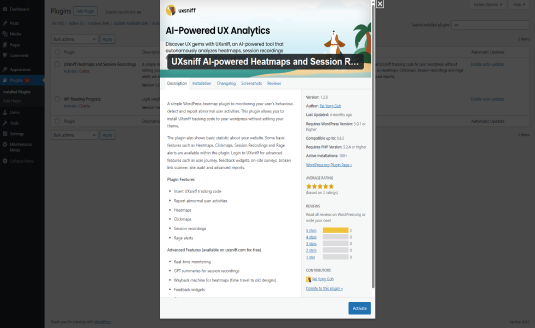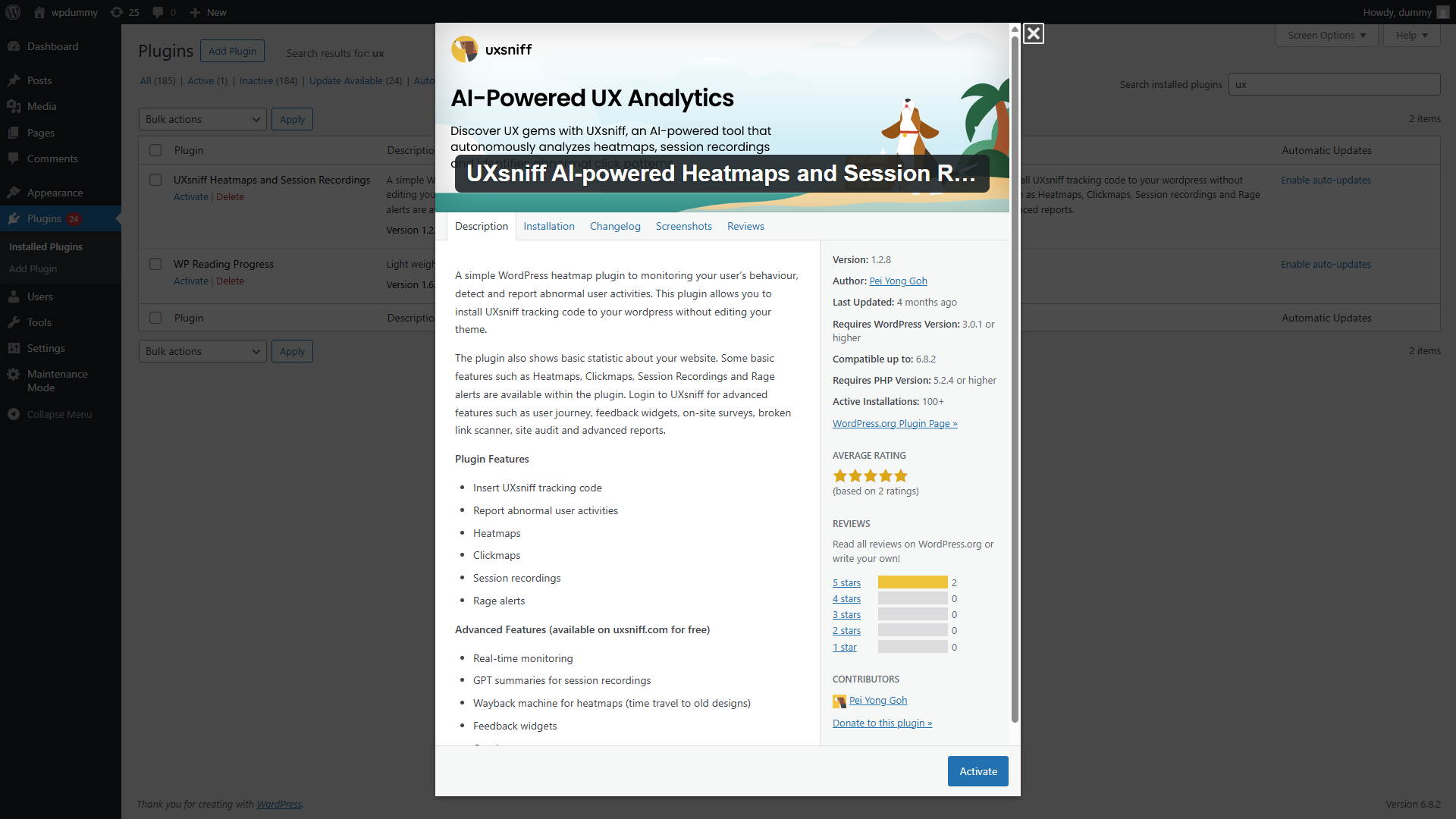UXsniff – AI-powered Heatmaps and Session Recordings WordPress Plugin
In today’s digital age, user experience (UX) has become the central factor that determines whether a website succeeds or struggles. With countless websites competing for attention, businesses need to understand not just what visitors are doing on their sites but why they are doing it. This is where UXsniff – AI-powered Heatmaps and Session Recordings comes into play.
UXsniff is a WordPress plugin designed to provide deep insights into user behavior by leveraging AI-powered heatmaps, session recordings, feedback tools, and analytics. Unlike traditional analytics solutions that focus primarily on numbers, UXsniff helps site owners visualize interactions, track engagement, and identify pain points in real time. With this plugin, website administrators, marketers, and UX designers can improve usability, optimize conversions, and ultimately provide a seamless experience for their visitors.

What is UXsniff?
UXsniff is a behavior analytics plugin that integrates directly with WordPress websites. It enables website owners to record and replay user sessions, generate click and scroll heatmaps, collect feedback from visitors, and apply artificial intelligence to detect friction in the user journey.
At its core, UXsniff aims to answer critical questions:
- Where do users click most often?
- How far down do they scroll on each page?
- Why do they abandon forms or shopping carts?
- Which elements cause frustration or confusion?
By capturing real user interactions, UXsniff offers actionable insights that help businesses refine website design, boost conversions, and deliver better experiences.
Key Features of UXsniff
1. AI-powered Heatmaps
Heatmaps are one of UXsniff’s standout features. They visually represent user interactions, showing where visitors click, move their cursors, and scroll. The AI-powered algorithms help identify unusual behavior patterns, such as rage clicks (repeated clicks on non-functional elements), missed interactions, or ignored sections.
- Click Heatmaps: Show which buttons, images, or links get the most engagement.
- Scroll Heatmaps: Indicate how far users scroll down a page and where they lose interest.
- Attention Maps: Highlight which areas hold visitor focus and which are overlooked.
These visual reports make it easy for non-technical users to understand user behavior without sifting through complex analytics data.
2. Session Recordings
UXsniff allows you to record and replay actual visitor sessions. You can watch exactly how users navigate your website—where they click, how they scroll, and what paths they take before exiting.
This feature is invaluable for identifying usability issues such as:
- Confusing navigation menus
- Unresponsive buttons or links
- Abandoned forms
- Friction in the checkout process
Instead of guessing why a visitor left without converting, you can watch their journey and pinpoint the exact obstacles.
3. AI-driven Friction Detection
One of UXsniff’s unique selling points is its AI engine, which automatically detects friction points in the user journey. It tracks signs of frustration such as:
- Rage clicks
- Dead clicks (clicks on non-interactive elements)
- Rapid back-and-forth navigation
- Form errors
This saves time by eliminating the need to manually analyze thousands of recordings. The AI highlights critical issues that need attention, helping businesses fix problems faster.
4. Feedback Collection Widgets
Understanding quantitative data is important, but qualitative insights matter too. UXsniff includes customizable feedback widgets that allow site owners to collect opinions directly from users.
For example:
- A simple feedback poll asking “Was this page helpful?”
- An exit survey asking why users are leaving the site.
- A rating widget for product or service pages.
These tools combine numerical data with real user feedback, providing a complete picture of website performance.
5. Conversion Funnels
UXsniff helps track how users progress through funnels, such as signing up for a newsletter, completing a form, or making a purchase. The plugin highlights drop-off points, so you can understand why users fail to complete their goals.
For eCommerce stores, this feature is especially powerful as it provides insight into abandoned carts, failed checkouts, and incomplete purchases.
6. GDPR & Privacy Compliance
Privacy and compliance are major concerns for website owners. UXsniff is designed with GDPR compliance in mind, ensuring that sensitive data such as passwords and personal details are never recorded. The plugin provides masking options to protect user information while still delivering valuable insights.
7. Simple Integration with WordPress
As a WordPress plugin, UXsniff can be installed and activated within minutes. The interface is designed to be intuitive, so users don’t need technical expertise to start recording sessions or generating heatmaps. Additionally, the plugin works seamlessly with most themes and plugins, making it suitable for blogs, business websites, and WooCommerce stores alike.
Benefits of Using UXsniff
- Improved User Experience (UX): By identifying friction points, you can create a smoother, more enjoyable browsing experience for visitors.
- Higher Conversion Rates: Understanding where users drop off helps you optimize conversion funnels, whether it’s for sales, signups, or downloads.
- Data-driven Decision Making: Instead of guessing which design changes will work, you can rely on real user data and behavior patterns.
- Time-Saving AI Analysis: The AI engine automatically flags issues, reducing the time needed to sift through recordings manually.
- Increased Revenue: A better-optimized site with improved usability directly contributes to higher sales and customer satisfaction.
- Reduced Bounce Rates: By analyzing scroll depth and engagement, you can adjust content placement and layout to keep users engaged.
Use Cases
- E-commerce Stores: Identify why shoppers abandon carts, improve product page layouts, and streamline checkout processes.
- Blogs & Content Websites: Understand which sections of content are most engaging and adjust layouts to maximize reader retention.
- SaaS & Service Websites: Track how potential customers interact with landing pages, forms, and pricing pages to improve signups.
- Agencies & Designers: Provide clients with behavioral insights and visual reports to justify design improvements.
UXsniff vs Traditional Analytics
While tools like Google Analytics provide numerical insights such as page views, bounce rates, and conversion numbers, they don’t explain why users behave a certain way. UXsniff bridges this gap by showing actual user interactions.
- Google Analytics: Tells you how many visitors bounced from a page.
- UXsniff: Shows you the exact recording of why they left—whether it was a broken link, poor form design, or unclear navigation.
This combination of quantitative and qualitative data makes UXsniff a more powerful optimization tool.
Pricing and Plans
UXsniff offers both free and premium plans. The free version is suitable for small websites, providing limited session recordings and basic heatmaps. Paid plans unlock advanced features such as unlimited recordings, AI friction detection, and funnel tracking. Pricing is flexible, making it accessible to startups, small businesses, and enterprises alike.
Final Thoughts
UXsniff – AI-powered Heatmaps and Session Recordings is more than just an analytics plugin. It’s a comprehensive UX optimization tool designed to help WordPress website owners truly understand their visitors. By combining AI insights, visual heatmaps, session recordings, and feedback collection, UXsniff offers everything you need to improve usability, increase conversions, and enhance overall customer satisfaction.
In a competitive online landscape, user experience is the deciding factor between a visitor staying or leaving. With UXsniff, you no longer have to rely on guesswork. Instead, you gain clear, actionable insights into how your audience interacts with your website—and the ability to make smarter, data-driven decisions that boost growth.





